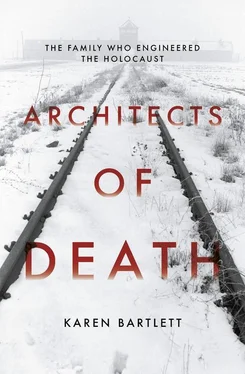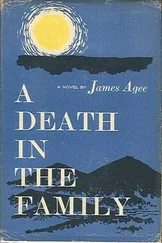Until the outbreak of war there were three main categories of prisoners. Criminals had a green triangle on their uniforms, while political prisoners, mostly communists, had a red triangle. The uniforms of Jewish prisoners bore a yellow star. Buchenwald also had several hundred Jehovah’s Witnesses, who had a purple star on their uniforms, and forty-three gay men who had a pink star. The number of inmates rose significantly during the war, but looking at a timeline of arrivals in the late 1930s the following main points stand out: by spring 1938 the camp held 2,500 men. In June that number was bolstered by 500, when the first Jewish prisoners arrived. Then, in September 1939, a further 2,300 political prisoners arrived from Dachau. But by far the greatest influx of prisoners occurred in November and December 1938, after Kristallnacht. More than 10,000 Jewish prisoners were rounded up and committed to Buchenwald, but most were released again after pledging to leave Germany.
During these years Buchenwald was officially designated a Category II camp, for prisoners who could be ‘reformed’, but only with difficulty. (By comparison Mauthausen was the only Category I camp, for prisoners deemed impossible to reform, Dachau was a Category III camp where it was supposedly easier to gain release.)
Yet for those imprisoned within its 3 km of electrified fencing, this must have seemed the most arbitrary of designations. Life for inmates at Buchenwald was designed to be as intolerable and inhumane as possible. Later in the history of the camp, the SS would recognise the economic benefits it could reap from such a large slave-labour population – but in the beginning the emphasis was less on ‘efficiency’ and far more on punishment and probable death, usually at the hands of sadists and psychopaths. Before the outbreak of war, Buchenwald had the highest mortality rate of any concentration camp.
The regime of Buchenwald’s first commander, Karl-Otto Koch, and his equally detested wife, Ilse, was characterised by capricious cruelty, corruption and graft. Prisoner William Gellinick recalls hearing Ilse Koch saying to her husband: ‘My little pigeon, I think it is time for that old man to grovel a bit,’ before the prisoner was made to roll up and down a hill, sustaining injuries which led to his death. The Kochs had two children during their time in charge of Buchenwald, and Karl Koch was photographed with his small son petting a deer in the grounds of the Buchenwald Zoo, which was located just outside the perimeter fence, overlooking the crematorium. The caption in the Koch family photo album read: ‘At the zoo with Daddy’.
Visibly resisting any rules led to certain death, and the SS specialised in introducing conflicting ones that made it impossible to survive. For example, a guard would throw an inmate’s cap in the direction of the barbed wire fence and order him to fetch it. If he did so he was shot for trying to escape, if he refused he was shot for disobeying orders.
Those who survived the long hours of roll call, standing outside every morning and evening in snow and rain, could then be crushed to death by falling boulders in the quarry or hit by runaway loading cars. In one such ‘occupational accident’, Jewish inmate Horst Loewenberg was chased to his death by a lorry driven by the SS.
Prisoners were routinely tortured. They were hung from trees in the woods and whipped, or locked up in the infamous arrest cells run by notorious sadist Martin Sommer – who liked to personally strangle his victims and kept an electrified skull on his desk. Those who did not die from overwork or torture could starve on the tiny rations of food (prisoners were allowed no more than 550 grams of bread with a small piece of sausage, some thin soup and ¼ litre of drinking water per day, but were often served half of this portion), or be killed in one of the camp’s notorious medical experiments where they were injected with typhus, yellow fever or diphtheria, or horrifically burned with phosphorus. Many died due to lack of sanitation (the camp had toilets, but no running water for years); disease was rife and prisoners were left to fester without treatment.
It was this hellish combination of punishment, torture, non-existent sanitation and complete lack of regard for human life that brought Topf and Sons into contact with Buchenwald – and into bed with the SS.
Between 1937 and 1940, bodies from Buchenwald were transported down the hill for cremation in the main Weimar crematorium, and, from the first, the SS had subverted and broken German law. The law stated that family members had to consent to cremation in writing beforehand, but this agreement was set aside in the case of the inmates of Buchenwald as early as 27 September 1937, when Weimar’s Chief Burgomaster wrote:
I hereby consent to the petition by the concentration camp commander to carry out the cremation of the corpses for a lump sum fee of 20 RM. I request that the camp command headquarters be informed of this and be instructed that the certificate required according to Article 3, Item 2 of the Reich law governing cremation be submitted at the time of the transport of the corpse. For the sake of simplicity I am enclosing a number of forms… [32] Gedenkstätte Buchenwald (ed.), op. cit., p. 20.
The form, which was supposed to be submitted by a family member, could now be filled in and signed by the SS in Buchenwald.
Yet, even setting aside the inconvenience of cremation law, the SS could not completely overcome some of the logistical problems of disguising the murder of mass numbers of people, and the disposal of their bodies.
The transportation of the bodies often drew unwanted attention to camp conditions, when, on at least one occasion, the crude boxes housing the bodies fell off the lorry that was transporting them, splitting and causing bodies to roll into the road. ‘Corpses lay on the pavement for everybody to see; the bodies looked “mutilated”’, remembered one undertaker’s helper. [33] Kater, op. cit., p. 266.
In addition, the scale of the task was noticeable, taxing town facilities to the limit. In the three years between 1937 and 1940, the bodies of 2,000 inmates were cremated in local crematoria and, as conditions in the camp worsened, the death toll continued to rise.
Buchenwald prisoner Erich Haase wrote:
In the Polish camp, in the winter of 1939/40 alone, 40–70 comrades were dying every day. Either from dysentery or from camp fever, or from being beaten to death or being murdered in other terrible ways, with the result that so many bodies were being taken to surrounding towns for cremation that the crematoria in Weimar, Jena and Leipzig simply couldn’t cope with them all. [34] Schüle, op. cit., p. 108. AS footnote 164: Erich Haase in Das war Buchenwald [ This was Buchenwald ], Leipzig, p. 79.
In comparison, a small town at the time would average only twenty-five cremations per month, with the number for large towns reaching only 100.
The rising death toll did not surprise the SS – they had caused it. In October 1939, filthy hygiene led to an outbreak of dysentery in the ‘special Polish camp’ in Buchenwald that held 3,000 people including Jews and non-Jewish Poles, and Jews from Vienna. The SS did nothing to eradicate or prevent prisoners from contracting the disease, and instead left 800 people to starve or die from infection.
Prisoner Walter Poller was a medical recorder in the quarantined camp; he made the following report:
The living with the dead, the healthy with the dying, old men with children, the terrified and the fatalistic. Unbelievable blight, indescribable filth, people rotting while they still lived, mad people writhing in spasms, people in comas… an apocalypse such as no brain could ever invent and no pen describe. [35] Schüle, op. cit., pp. 107–108. AS footnote 162: Buchenwald Memorial, Konzentrationslager Buchenwald 1937–1945. Begleitband zur ständigen historischen Ausstellung [ Buchenwald Concentration Camp, 1937–1945: A Guide to the Permanent Historical Exhibition ] , Göttingen, 2005, pp. 115–18.
Читать дальше












